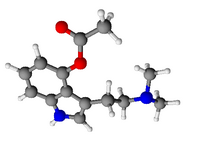O-Acetylpsilocin
This article needs additional citations for verification. (March 2011) |
 | |
 | |
| Clinical data | |
|---|---|
| Other names | 4-Acetoxy-N,N-dimethyltryptamine, 3-(2'-dimethylaminoethyl)-4-acetoxy-indole[1] |
| Routes of administration | Oral, IV, intranasal, rectal |
| ATC code |
|
| Legal status | |
| Legal status | |
| Identifiers | |
| |
JSmol) | |
| Melting point | 172 to 173 °C (342 to 343 °F) |
| |
| |
| (verify) | |
O-Acetylpsilocin (also known as psilacetin, 4-acetoxy-DMT, 4-AcO-DMT, or synthetic shrooms) is a semi-synthetic
History
O-Acetylpsilocin (psilacetin) and several other esters of psilocin were patented on January 16, 1963, by Sandoz Ltd via Albert Hofmann & Franz Troxler.[1][7] Despite this, psilacetin remains a psychedelic compound with a limited history of use. It is theorized to be a prodrug of psilocin, as is psilocybin, which occurs naturally in many species of psychedelic mushrooms. This is because the aromatic acetyl moiety on the 4th position of the indole ring system is subject to deacetylation in acidic conditions such as those found in the stomach.[8] Psilacetin is O-acetylated psilocin, whereas psilocybin is O-phosphorylated.
Chemistry
O-Acetylpsilocin can be obtained by acetylation of psilocin under alkaline or strongly acidic conditions. It is, therefore, a synthetic compound. It is believed to be a prodrug of psilocin; however, speculation exists that psilacetin itself also may be psychoactive. O-Acetylpsilocin is more resistant than psilocin to oxidation under basic conditions due to its acetoxy group. While O-acetylpsilocin is not well researched (sometimes viewed negatively as a research chemical, as opposed to psilocin and psilocybin), it is not as difficult as psilocybin to synthesize. Due to their similar proposed mechanisms of action, this factor may provide further support for the proposition that O-acetylpsilocin might serve as an appropriate substitute for psilocybin in research of the application of psychedelic compounds in medicine.[2]
Given enough time in unfavorable conditions O-Acetylpsilocin can sometimes turn into a degraded form which is brown in color and can even progress into a brown/black goo of sorts. This is hypothesized to be a polymerization reaction and is said to have no effect on the potency of the drug. Preliminary GCMS analysis of the closely related homolog 4-Acetoxy-DET suggests that this degraded form of O-Acetylpsilocin consists mainly of the hydroxy form of the parent molecule.[9]
Pharmacology
- See psilocin for more details.
In the body O-acetylpsilocin is
Claims of subjective differences in effects between the acetylated and non-acetylated forms of psilocin vary:

Legality
This article needs additional citations for verification. (March 2011) |
Australia
O-Acetylpsilocin can be considered an analog of psilocin making it a Schedule 9 prohibited substance in Australia under the Poisons Standard (October 2015).[10] A Schedule 9 substance is a substance which may be abused or misused, the manufacture, possession, sale or use of which should be prohibited by law except when required for medical or scientific research, or for analytical, teaching or training purposes with approval of Commonwealth and/or State or Territory Health Authorities.[10]
United States
O-Acetylpsilocin is ambiguously legal for use as a lab reagent or research chemical; however, it is an acetate ester of psilocin, meaning it would be considered akin to a Schedule I Controlled Substance under the Federal Analogue Act if sold for human consumption.
United Kingdom
O-Acetylpsilocin, being an ester of psilocin, is a
Czech Republic
O-Acetylpsilocin is prohibited in Czech republic except strictly limited research and therapeutical purposes.[12]
Italy
O-Acetylpsilocin is illegal in Italy as it is an ester of a prohibited substance.
Sweden
The Riksdag added 4-AcO-DMT to Narcotic Drugs Punishments Act under swedish schedule I ("substances, plant materials and fungi which normally do not have medical use" ) as of January 25, 2017, published by Medical Products Agency (MPA) in regulation HSLF-FS 2017:1 listed as 4-acetoxi-N,N-dimetyltryptamin.[13]
Israel
O-Acetylpsilocin is technically illegal in Israel as of being a derivative of DMT.
See also
- 4-AcO-DPT
- 4-MeO-DMT
- 4-PrO-DMT
- ALD-52
- Ayahuasca
- Psilocybin
- Psilocybin mushroom
- Psychedelic drug
- Serotonergic psychedelic
- Tryptamine
References
- ^ a b US patent 3075992, Hofmann A, Troxler F, "Esters of indoles", assigned to Sandoz Ltd.
- ^ (PDF) from the original on 17 February 2012. Retrieved 17 January 2012.
- ^ Bauer BE (2019-09-18). "The State of the Art of Psilacetin (4-AcO-DMT)". Psychedelic Science Review. Retrieved 2021-02-13.
- ^ a b "4-AcO-DMT (also 4-acetoxy-N,N-dimethyltryptamine) : Erowid Exp: Main Index". www.erowid.org. Archived from the original on 2010-07-28.
- ^ Janikian M (2020-05-26). "The Complete Guide: 4-AcO-DMT a.k.a. Synthetic Shrooms". DoubleBlind Mag.
- PMID 31909513.
- ^ US 3075992
- .
- ^ "Erowid 4-Acetoxy-DET Vaults : 4-Acetoxy-DET / Ethacetin Degradation". erowid.org. Retrieved 10 September 2023.
- ^ a b "Poisons Standard October 2015". Federal Register of Legislation. Australian Government. Archived from the original on 2016-01-19. Retrieved 2016-01-06.
- ^ Misuse of Drugs Act 1971 (Schedule 2 Part I). 1971.
- ^ "Government regulation of the list of the addictive substances". Federal Register of Legislation. Czech Government.
- ^ "Föreskrifter om ändring i Läkemedelsverkets föreskrifter (LVFS 2011:10) om förteckningar över narkotika" [Regulations on changes in the Swedish Medicines Agency's regulations (LVFS 2011:10) on lists of narcotics] (PDF) (in Swedish). Archived (PDF) from the original on 2017-10-31. Retrieved 2017-04-21.
External links
- 4-AcO-DMT information at IsomerDesign.com
- Erowid 4-Acetoxy-DMT Vault
- "Esters of Indoles" US Patent # 3,075,992 - Awarded to Sandoz Ltd. (via Albert Hofmann & Franz Troxler) on January 29, 1963.
